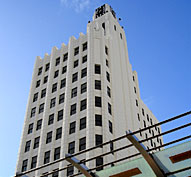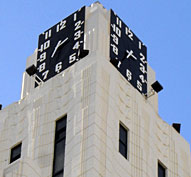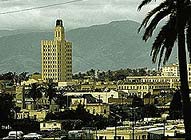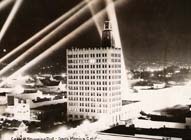




225 Santa Monica Boulevard
Architects: Walker and Eisen


Crocker Bank Building
225 Santa Monica Blvd.
photo by Michael Grandcolas

Clock Tower detail
photo by Michael Grandcolas

1929 Guaranty Trust Bank Building at 221-225 Santa Monica Blvd.

Central Shopping District - Santa Monica, CA 1952
The Bay Cities Guaranty Building at 225 Santa Monica Boulevard is located within the Bayside Commercial District adjacent to the Third Street Promenade. The Art Deco ornamentation of the building is defined by the alternating wide and narrow full-façade-height pylons flanking double-hung windows, creating an undulating pattern across the elevations, and terminating in a crenellated roofline. The Art Deco ornamentation also consists of zigzag patterns along the cornice with receded chevron patterns and upper story spandrels. The pylons and zigzag motifs are continued on the stepped clock tower.
When it was up for landmark nomination several years back, the landmark committee unanimous agreed that the familiar downtown area tower is an “iconic” structure.
“It’s literally a landmark,” said Commission Chair
Roger Genser, “because you look at the clock — if it’s
working- and know what time it is.”
Prior to landmarking, the Bay Cities Guaranty went through more than $6
million in rehabilitation. Over the years, changes were made to the 12-story
building including the application of two stories' worth of metal screening
along Santa Monica Boulevard. The screening was removed and the original
cast iron frame windows were rehabilitated. New entrance doors and hardware
designed to be compatible with the style and materials of the original
doors and new black granite were added to the base. The clock tower, face,
and hands will also be restored.
Like many of the properties in downtown Santa Monica, the Bay Cities Guaranty
building suffered notable damage in the Northridge Earthquake. As the
property was being qualified for landmark status, it underwent a $1.6
million seismic retrofit. Additionally, the four clocks adorning the clock
tower, which had been broken since the Northridge earthquake, went through
a $75,000 repair job. The 1929 clocks are now linked to a satellite system
that keeps the time accurate.
"It's all high-tech and computerized on the inside now," noted
project restoration manager Turner Smith, "But the structure you
see from the street is all original."
The Bay Cities Guaranty was designed by renowned Los Angeles area architects
Albert R. Walker and Percy A. Eisen. Another noteworthy Santa Monica Property
by Walker and Eisen was the French style beach home at 602 Palisades Beach
Road, which the architects designed for movie mogul Samuel Goldwyn in
1931. Other praised properties in the Walker and Eisen design portfolio
include the Ardmore Apartments in Los Angeles, the Hollywood Plaza Hotel,
the Beverly Wilshire Hotel in Beverly Hills, the El Mirador Hotel in Palm
Springs, the Edwards and Wildey Building, the Texaco Building, the Oviatt
Building (which was the tallest skyscraper in LA when it was built in
1928), and the Romanesque Fine Arts Building (Signal Oil Building) at
811 W. Seventh St in Los Angeles The Fine Arts Building, a designated
Historic Monument and winner of the "Historic Building Of The Year"
award, was completed in 1927 as a cultural Mecca for Los Angeles.
The deco architecture of the Bay Cities Guaranty is reminiscent of some
of the buildings that still remain on the Miracle Mile and in downtown
Los Angeles.